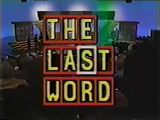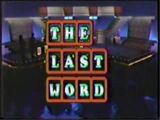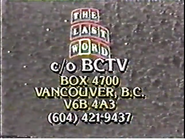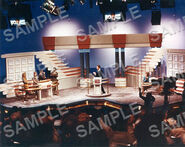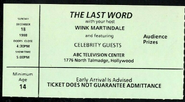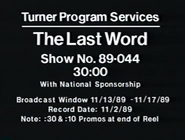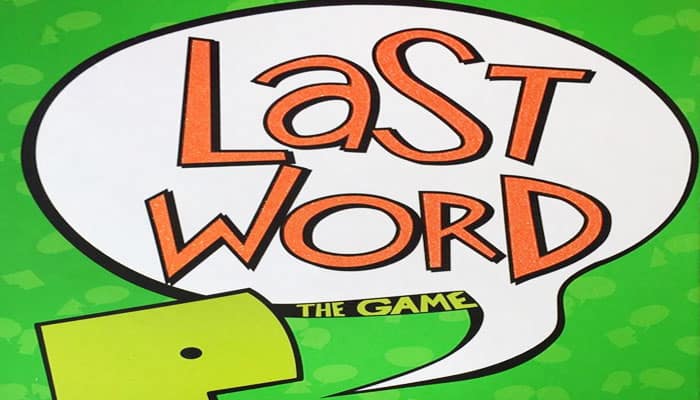The concept behind the game is simple; however, most people find it difficult to play.
But, in this short and precise article, we will follow a step-by-step process on how to play Last Word with ease.
This game also falls in the family of board games like Scattergories and Concept.
Components
- Scoring Gameboard
- Card Stacking Gameboard
- 230 Subject Cards
- 56 Letter Cards
- 8 Colored Pawns
- Electronic Random-Interval Timer
- Instructions
Object of the Game
Your goal is to be the first player to make it to the finish on the deck board.
Number of Players: 2-8
Time: 30 Min
Age: 8+
Setup
Place the two boards within easy reach of players.
Players then choose their colored pawns and place them on the start image of the left board.
After shuffling the deck of cards, arrange them, and place them in their appropriate spots on the deck board.
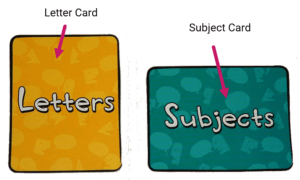
Gameplay
Switch on the buzzer at the back and place next to the deck board.
Each player is given one Trade-in token and also draws one subject card from the top of the deck. The player then looks at it and keeps it hidden from the other players.
A letter is also drawn from the deck and placed face down for all to see. Players will then try to come up with words that match the letter on the card.
The player comes up with a subject, places its face up, reads it for the other players to hear, names a word that fits the category, and switches on the buzzer.
The player who came up with the word and the other players as well will then try to come up with a word that fits the letter and the category.
The last player to say a word that fits the category played at the beep of the buzzer will move his or her pawn one space ahead of the others.
New round
The player that drew the subject card will draw it again with a new letter and the procedure repeats itself again.
Jumpstart challenge
Any player can call up a jump start challenge for the other players. To do so, say the word “JUMP START” and press the timer without drawing a subject card.
Players using their current category, and letter from the previous round will then have to come up with a new word before the timer ends. If they are able, they move two spaces ahead. If not, the Jumpstart challenger moves two spaces ahead.
You can trade-in your trade-in token cards to discard your current subject card for a new one.
Rules for acceptable words
- Repeated words are not allowed.
- Only real words are allowed. So, the legitimacy of a word can be challenged.
- Words said midway when the timer buzzes are not accepted.
Dealing with difficult subject cards
You can take some pity on any player who happens to have a very difficult subject card so they can draw a new one.
Conclusion
Learning to play Last word is a simple process. Just follow the rules and you will be okay.
If you love this hobby, check our other board games here.
To buy the game for yourself on Amazon, click below.

OBJECTIVE OF LAST WORD: The objective of Last Word is to be the first player to reach the finish space and have the last word.
NUMBER OF PLAYERS: 2 to 8 Players
MATERIALS: 1 Scoring Game Board, 1 Card Stacking Board, 1 Electronic Timer, 8 Pawns, 56 Letter cards, 230 Subject Cards, and Instructions
TYPE OF GAME: Party Board Game
AUDIENCE: Ages 8 and Up
OVERVIEW OF LAST WORD
Last Word is a hilarious party game that is perfect for those loud entertainers. Players blurt out answers, interrupt, and attempt to get in the last word before the timer goes off. The timer goes off at random intervals, so nobody can cheat by waiting until the last minute. Hurry, answer as fast as you can, and have a blast!
SETUP
Place the two boards in the middle of the table, ensuring that all players are able to easily reach them. The timer should be turned on. Each player will choose a color of pawn to represent their movements on the board. Everyone’s pawn is placed at the starting space on the scoring board.
Letter and subject cards are divided and shuffled separately. Once shuffled, they are placed in their assigned space on the card stacking board. These will form the two draw piles that will be used throughout the course of the game. Each player will take a card from the subject draw pile, reading it silently to themselves and hiding their card from other players. The game is then ready to begin.
GAMEPLAY
Any player can reveal the top letter card to get a round started. They will read it aloud to the group and place it face up on the assigned space. The players will then think of a word that starts with the letter but falls within the category of the subject card that they have.
The first player to sit their subject card on the card stacking board, read it to the group, and calls out something that falls in the category and starts with the letter will start the timer! All of the players must call out words that start with the letter and fall within that player’s category. Repeat words do not count, and players must be silent when the buzzer sounds
The last player to say a correct word before the timer goes off wins the round! They are then able to move their pawn one space closer to the finish line. If a player is in the middle of a word, then the player who last said a word wins the round. The player that played their card will draw a new one.
The new round will then begin. The game continues in this manner until a player reaches the finish space on the board.
END OF GAME
The game comes to an end when a player reaches the finish space on the board. The first player to do so, wins the game!
- Author
- Recent Posts
My name is Ellie! I am a resident of Northeast Tennessee. I love animals of all shapes and sizes, fantasy fiction novels, and anything outdoors. I have a wonderful husband who loves me almost as much as my two fur babies. I love being a part of this awesome community.
Loading…
| Host |
| Wink Martindale |
| Hostesses |
| Jana White (1988) Jennifer Lyall (1989) |
| Announcers |
| Burton Richardson (1988) Jennifer Lyall (1989) |
| Broadcast |
|
Pilot: 12/18/1988 Syndication (Daily): 9/18/1989 – 12/15/1989 (with reruns through 1/5/1990) |
| Packager |
| Merrill Heatter Productions |
| Distributor |
| Turner Program Services |
The Last Word was a word game where a group of words share a common bond, and where the last word means everything.
Gameplay[]
Two teams consisting of a celebrity and a civilian contestant competed to guess a series of groups of words that had something in common in order to win prizes. The civilians received all winnings credited to their teams. Among the celebrities who appeared include Jill Whelan, Ted Lange, Susan Ruttan, and Gordon Jump.
Main Game[]
To start, a puzzle consisting of three rows of blank squares (indicating how many letters were in each word) was revealed along with three free letters (one in each row). The player in control pressed a button which caused a yellow square to move around the board. When it landed on an empty square, a letter in that square was revealed and then the player had to decide to either take a guess on any word in any row or pass control to his/her opponent (that player also had the option to guess at the start of a turn); but if the yellow square landed on a square that already had a letter revealed, then the player had to choose which row & square in which to reveal a free letter.
When guessing the word, if the player guessed correctly they won that word; but if he/she guessed wrong, the computer typed in, from left to right, the letters that were correct (up to the first incorrect letter), except for the last letter, which remained hidden. After making a correct guess, he/she had the option to either guess another word or pass control. The first team to guess the last word in the group of three won the game. If they had solved only the last word, they won a rather cheap prize; two words won a better prize, and solving all three words and winning the game won the first two prizes & a bonus prize for that game. A game win was signified by a star lit up on the team’s podium. A best two-out-of-three match was played with the winning team becoming champion and advancing to the bonus round.
Unlike most celebrity-civilian word games, the arrangement of which people played in each game varied. In the first two games, the celebrity from one team competed against the civilian player from the other team. In the tie-breaker, both civilian players competed.
If time ran out in the middle of a puzzle, all the words were revealed and a new puzzle was played at the start of the next episode.
Bonus Round: 60-Second Challenge[]
In the bonus game, the winning team had 60 seconds solve 10 puzzles. Each puzzle had two words already revealed, they acted as clues to the third word, which was unrevealed (one letter was given at the outset). Letters in the mystery third word were revealed one at a time in random order (the last letter was not given) (similar to Scrabble’s Speedword). Each correct answer was worth a $100 gift certificate, but solving all ten puzzles won a jackpot grand prize package (which usually included a trip). Should that not occur, more prizes were added until won. The highest jackpot won during its short run was $46,500.
After the bonus round, both players switched celebrity partners for each new game, and the first player to win two matches became the champion and remained on the show to face a new challenger, competing until they were defeated or played six 60-Second Challenges, whichever came first.
Pilot Rules[]
The pilot was similar to the series, but it had several differences:
- The pilot was taped in Los Angeles, CA while the series was taped at BCTV in Vancouver, BC.
- There was a different hostess named Jana White who worked the computer and the announcer was Burton Richardson.
- Players stopped the square which was white with the use of a lever instead of starting the yellow one by hitting the button.
- Words were worth a straight-up $100 in cash to the winner of each round, for a maximum total of $300. $100 in cash per word was also offered in the 60-Second Challenge instead of just prizes; meaning that winning the bonus was worth $1,000 in cash and a jackpot prize package.
Stations[]
Stations that aired this included:
Dallas/Fort Worth — KDAF
Cedar Rapids — KOCR
Des Moines — KDSM
Portland, OR — KPDX
Los Angeles — KTTV
Green Bay — WXGZ
Chicago — WFLD
New York — WNYW
Philadelphia — WGBS
Baltimore — WBFF
Washington D.C. — WTTG
Albuquerque — KLUZ
Minneapolis — KMSP
Sacramento — KSCH
Greenville, SC — WYFF
Charlotte — WCNC
Greensboro — WXII
Norfolk — WTVZ
Denver — KMGH
Detroit — WXON
Huntsville, AL — WZDX
Trivia[]
Tony Reitano, one of the contestants from the pilot, would later appear in the 1990 Gambit pilot (another Merrill Heatter game show) and an episode of Jumble: The Interactive Game. Back in 1981 and before appearing on the pilot, he was one of the two top winners on The $50,000 Pyramid.
Additional Page[]
The Last Word/Catchphrases
Rating[]
Music[]
Michael Camilo for Score Productions
Sound Effects[]
The sound when a letter was revealed was the Fast Money answer reveal sound in Family Feud; also, the sound heard if the cursor stopped on a letter already given was the ring-in sound from Family Feud as well.
Gallery[]
Trade Ads[]
Contestant Plug[]
Set Pic[]
Tickets[]
Production Slate[]
Links[]
The Last Word Rules
YouTube Videos[]
Pilot Episode
- Part 1
- Part 2
Preview Episode featuring Jamie Farr and Michele Scarabelli
Series Premiere featuring Ted Lange and Jill Whelan of The Love Boat
Meredith MacRae and Peter Marshall
June Lockhart and Dick Van Patten
Contestant Rich Bowen
Pat Harrington Jr. & Edie McClurg
- Part 1
- Part 2
Components
- Scoring Gameboard
- Card Stacking Gameboard
- 230 Subject Cards
- 56 Letter Cards
- 8 Colored Pawns
- Electronic Random-Interval Timer
- Instructions
Object of the Game
Be the first player to move your pawn from Start to finish by racing opponents — and the random timer — to say the last word.
All players shout out words that fit Subject and Letter Cards in each round. The last player to call out a correct item before the timer buzzes scores!
Setup
-
Place the two gameboards and timer in the center of the playing area so they are equally accessible to all players.
-
Switch the timer to the «ON» position located on the underside of the unit.
-
Have each player choose a colored pawn and place it on the Start space of the Scoring Gameboard.
-
Separate the Letter and Subject Cards, shuffle each deck separately, and place them face-down on their respective areas of the Card Stacking Gameboard. These piles form the Letter draw pile and Subject draw pile.
-
Have all players take one card from the top of the Subject Card draw pile. Each player reads his card silently and keeps the content of the card hidden from other players.
Game Play
-
To start a round, any player turns over the top Letter Card, reads it aloud, and places it face-up on the space provided. 7//? is a Hot POTdTO card, skip to the next section to see how to play those rounds.
-
ALL PLAYERS now try to come up with a word that starts with the letter and fits the category of the Subject Card they are holding.
-
The first person who sets their Subject Card face-up on the Card Stacking Gameboard reads it aloud and calls out something that starts with the current letter and fits the subject.
That player then IMMEDIATELY starts the random-interval timer by pressing the button!
-
There are no turns. All players (including the one who pressed the timer) now simultaneously blurt out any other words starting with the letter and fitting the subject.
-
Players continue saying words until the timer buzzes. Repeat words do not count.
-
The last player to completely finish saying a valid word before the timer buzzes wins the round and advances their pawn one space on the gameboard, towards Finish. If the timer buzzes while someone is in the middle of a word, that response does not count and the previous valid word scores.
-
The player who played his or her Subject Card draws a new one.
-
A new round begins with any player turning over the next Letter Card. If this draw pile runs out. shuffle all face-up Letter Cards to form a new one.
The first player to advance to the Finish space wins the game!
Hot Potato Cards;
When a 
How to Play a Hot Potato Round:
-
When a Letter Card marked HOT POTATO is turned over. ALL PLAYERS still try to play the Subject Card they are holding as in a normal round.
-
Also as in a normal round, the first person who sets their Subject Card face-up on the Card Stacking Gameboard reads it aloud and calls out a word that starts with the current letter and fits the subject.
That player then IMMEDIATELY starts the random-interval timer by pressing the button — the game of HOT POTATO begins!
-
Players now take turns in a clockwise order! The player to the left of whoever started the HOT POTATO round now quickly says a valid word that fits the current letter and subject.
After that person says something valid, play IMMEDIATELY passes to the next player on the left.
-
Play continues to move clockwise until time expires.
-
When the timer buzzes, whosever turn it was losing the round and moves their pawn backward one space on the gameboard, towards Start. Players can never move back past the Start space.
-
Play returns to normal when the next Letter Card is turned over — unless it is also a Hot Potato card.
Challenges
Inevitably, one of your friends will try to pull a fast one and slip in a completely bogus word or play a Subject Card without already having an item in mind. It is the group’s job to keep them in line.
Don’t believe «Somewhere with Tall Buildings» is a valid U.S. city? Speak up! Any response can be challenged by the group and majority rules. If the bogus word was the Last Word, the last valid response wins the round.
Strategy
There isn’t any! If you knew how much time you had each round, you could try to wait until the last moment to blurt out words in hopes of winning. BUT the Last Word timer is unpredictable, so just keep blurting out words and hope for the best!
Difficult Subject Card
Sometimes a player will end up with a Subject Card that just isn’t hitting the spot.
If someone is holding on to a card for a long time and can’t come up with a word during a bunch of rounds, take pity on them and let them draw a new Subject Card.
Continue Reading
From Wikipedia, the free encyclopedia
The Last Word is a game show seen in syndication in the United States and on the Global Television Network in Canada that was produced by Merrill Heatter Productions and ran for 65 episodes from September 18 to December 15, 1989, with reruns continuing until January 5, 1990. The host was Wink Martindale, and the co-host/announcer was Jennifer Lyall. It was taped in Vancouver, British Columbia. In the Los Angeles-produced pilot, Burton Richardson was the announcer, and Jana White operated the computer and acted as co-host. The show was distributed by Turner Program Services.
Gameplay[edit]
Two teams consisting of a celebrity and a civilian contestant competed to guess group words that had something in common in order to win cash and prizes. The civilians received all winnings credited to their teams. Among the celebrities who appeared include Jill Whelan, Ted Lange, Susan Ruttan, and Gordon Jump.[1]
Main game[edit]
A puzzle consisting of three rows of blanks was displayed, representing three related words, and one letter of each word was filled in at the outset. The player in control pressed a button to stop a randomizer that flashed around the board. If it stopped on an empty space, that letter was filled in and the player could either try to guess the word or pass control to the opponent. When a player guessed, the remaining letters were revealed one at a time, starting from the leftmost, until either they had all been revealed (indicating a correct guess) or a letter came up that differed from the guess. However, the final letter of any word remained hidden on an incorrect guess.
A correct guess awarded the option to either guess another word or pass, while an incorrect guess gave control to the opponent. If the randomizer stopped on a letter that had already been filled in, the player had to choose one unrevealed letter in any word to be filled in and the opponent took control.
The player who solved the last word won the puzzle, regardless of who solved the first two, and received prizes for the team based on the number of words he/she had solved in that puzzle. The first team to win two puzzles won the match and advanced to the bonus round. Only one person played for each team at any given moment; the first two puzzles were played by one celebrity and the opposing civilian, and the third (if necessary) was played by both civilians.
If time ran out in the middle of a puzzle, all the words were revealed and a new puzzle was played at the start of the next episode.
Bonus round: The 60 Second Challenge[edit]
The winning team had 60 seconds to solve 10 puzzles. For each puzzle, two one-word clues were given and the letters of a third word were revealed one at a time until only one letter remained. Multiple guesses were allowed from either member. The team won a $100 gift certificate for each correct answer, and solving all 10 won a prize package which had a new prize added to it for each attempt in which it was not won; the largest jackpot awarded during the show’s brief run was $46,500.
The civilians switched celebrity partners after each bonus round, and the first civilian to win two matches became champion and remained on the show to face a new challenger, competing until they were defeated or held their title for a total of six matches, whichever came first.
References[edit]
- ^ TV Guide Guide to TV. Barnes and Noble. 2004. pp. 357. ISBN 0-7607-5634-1.
External links[edit]
- The Last Word Rules






